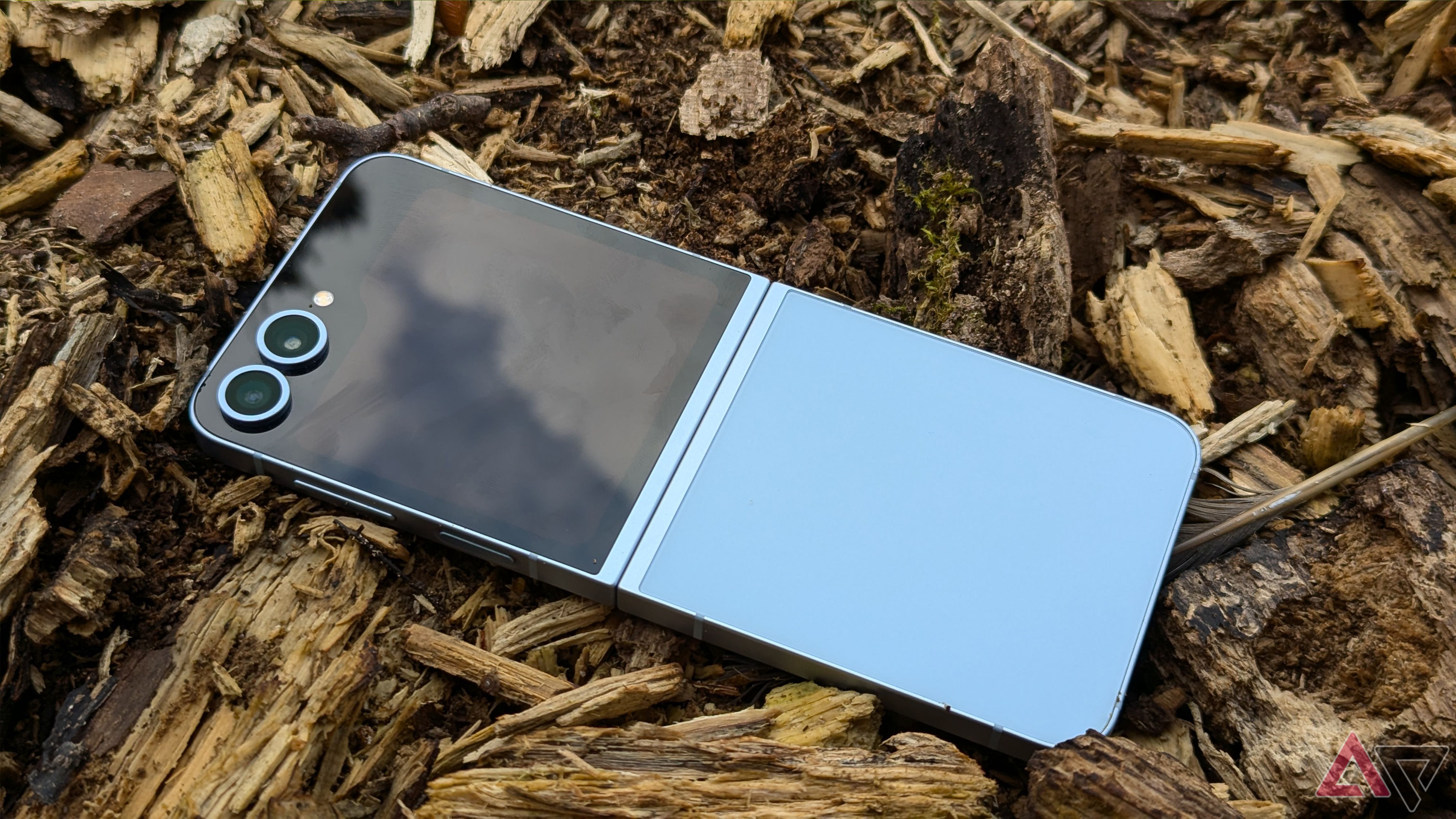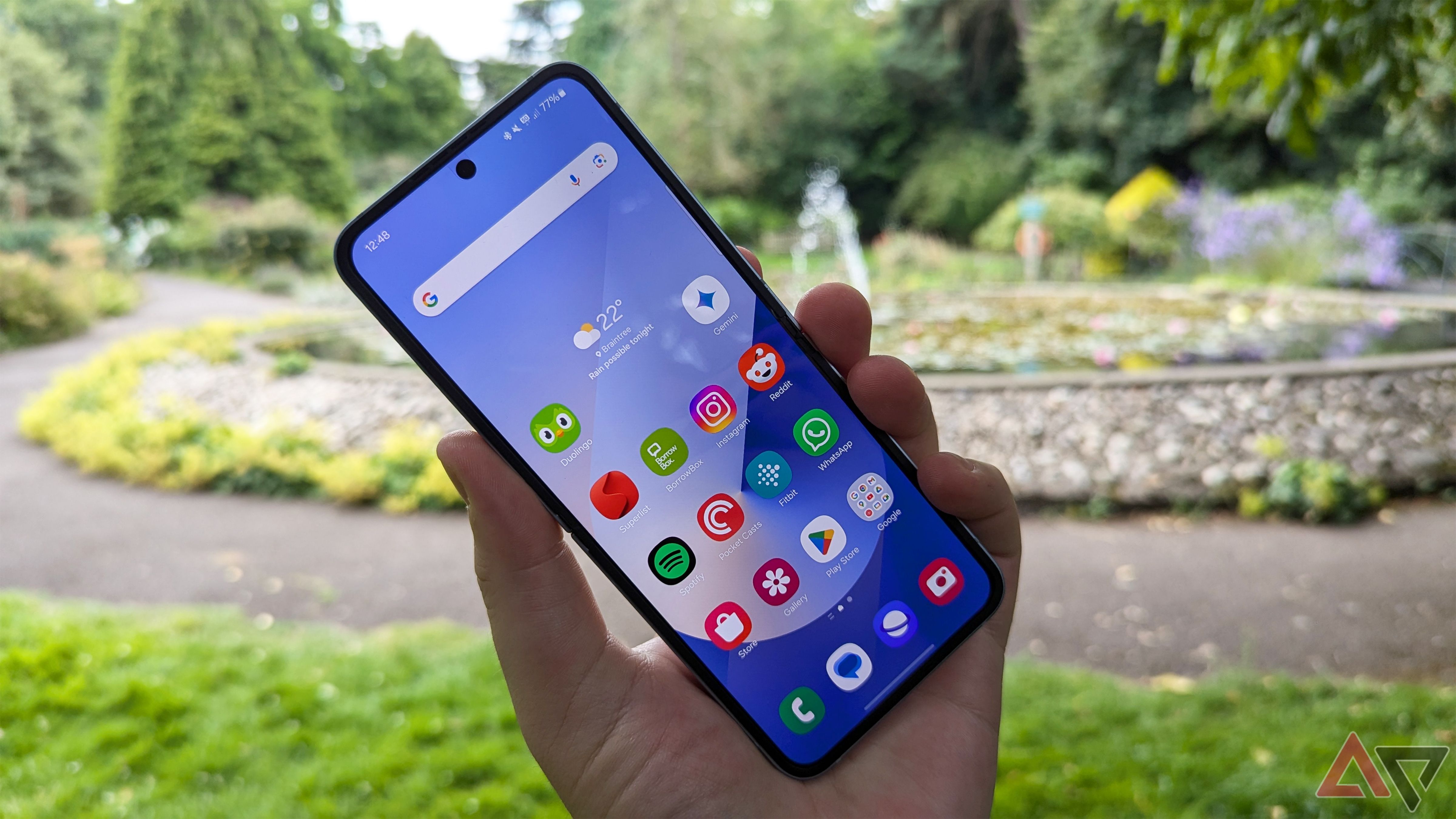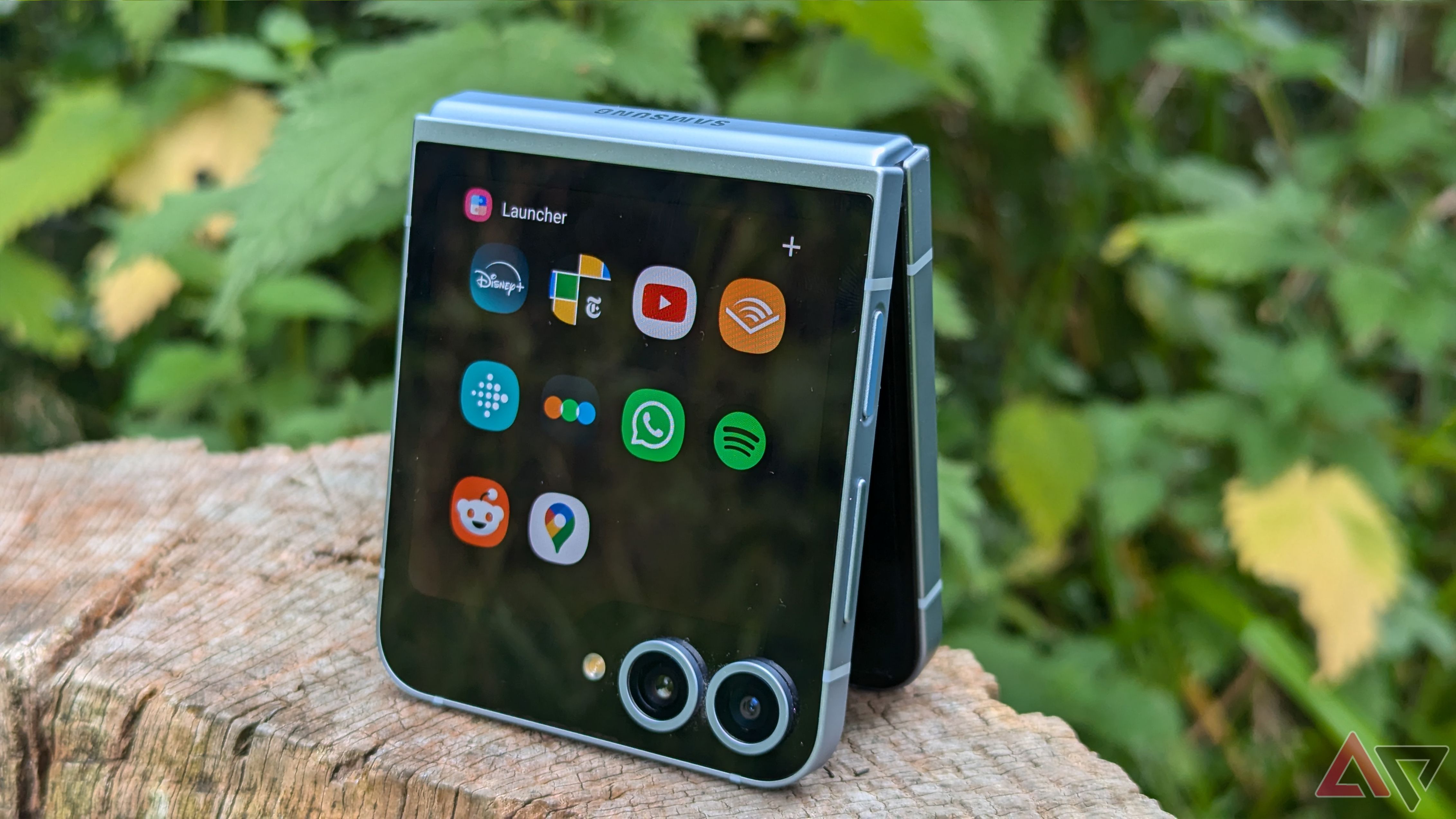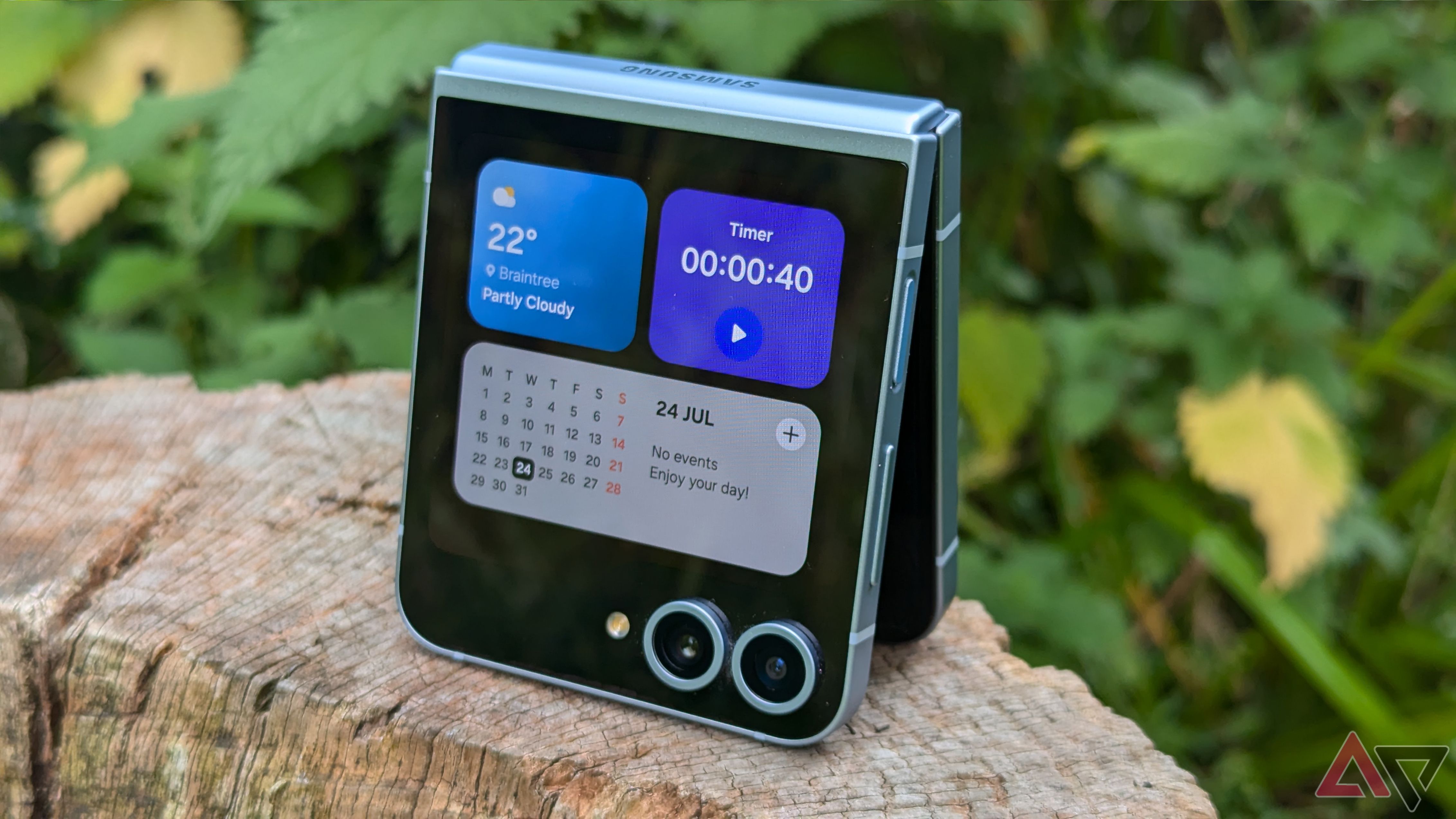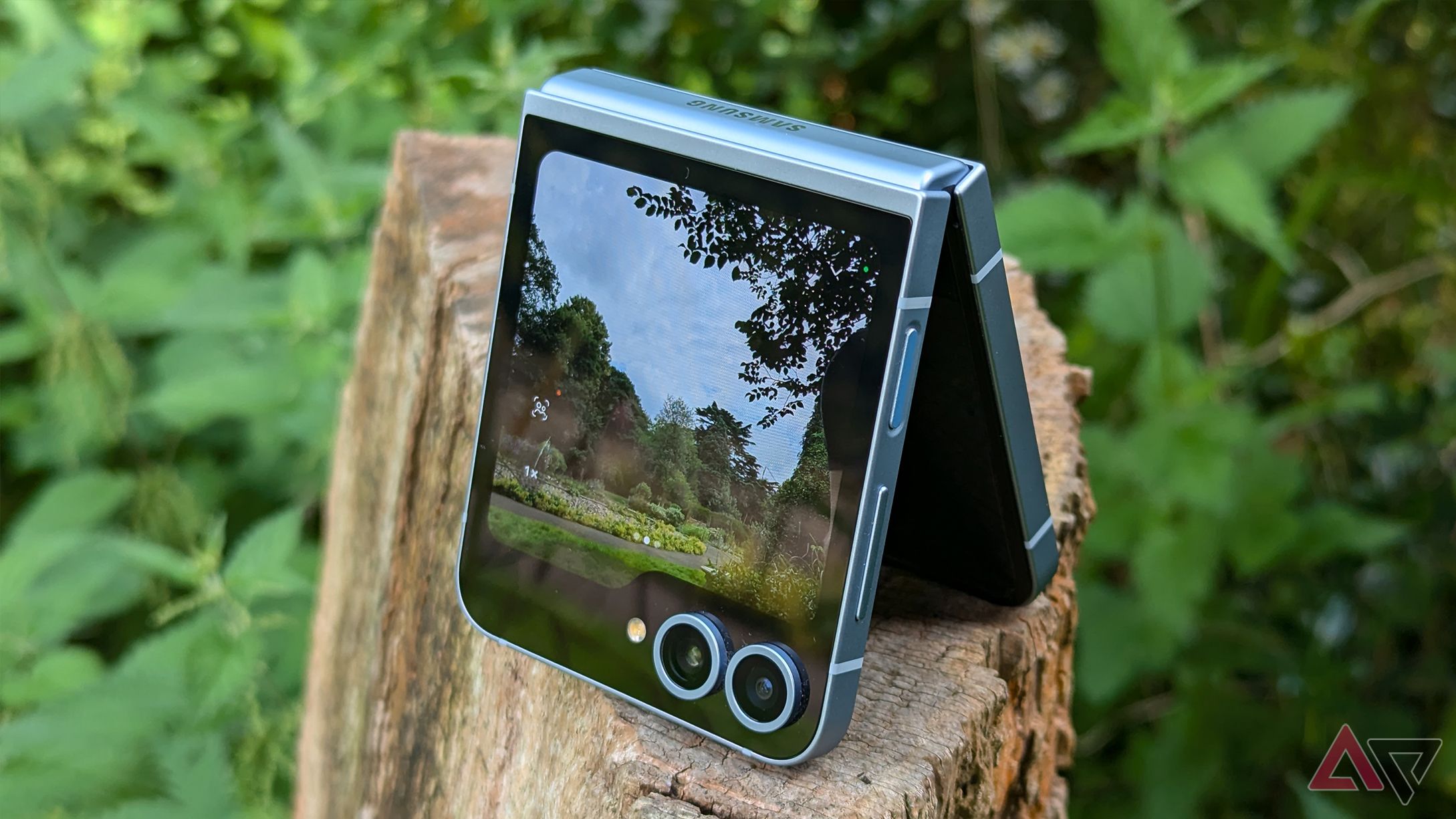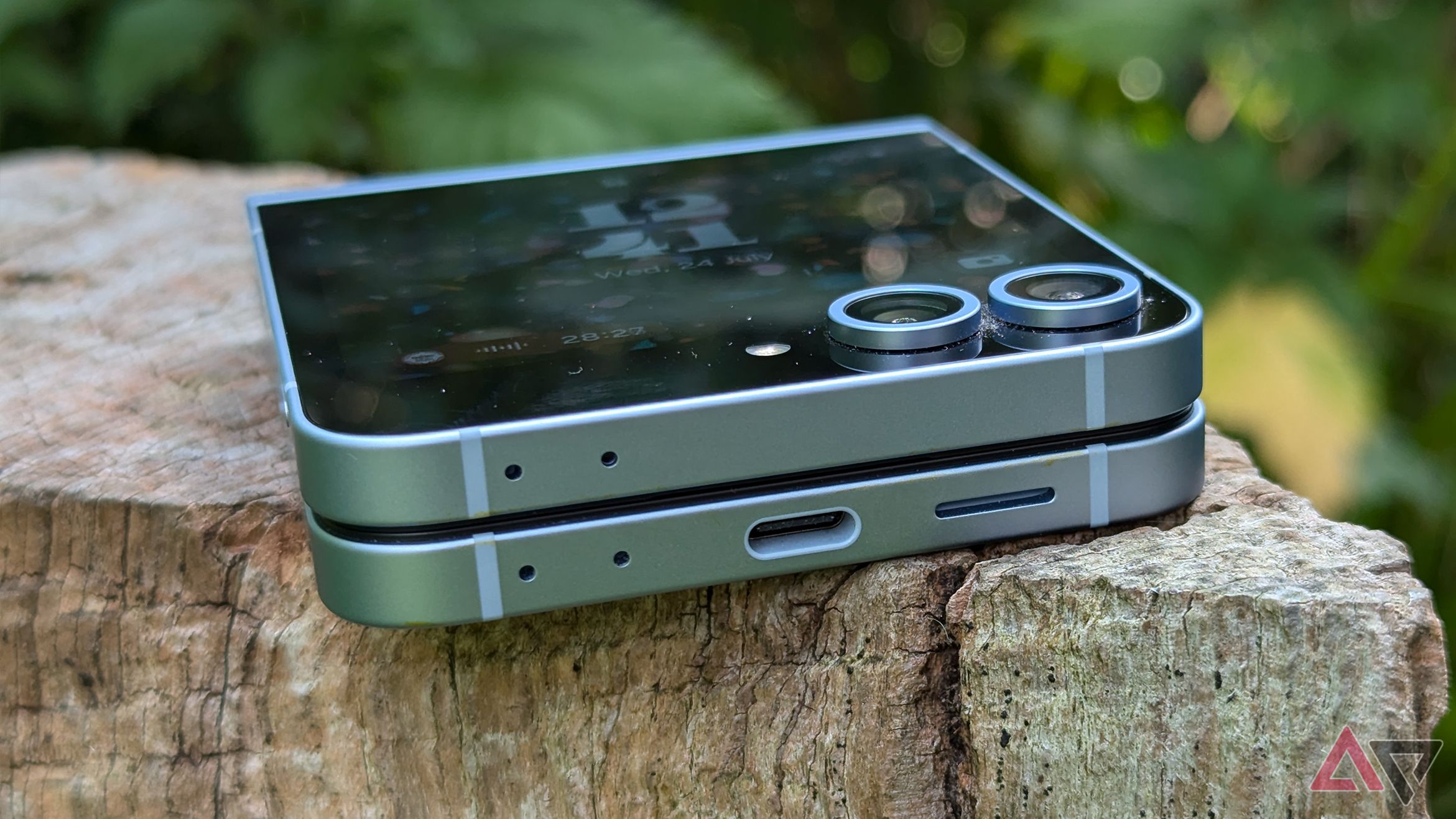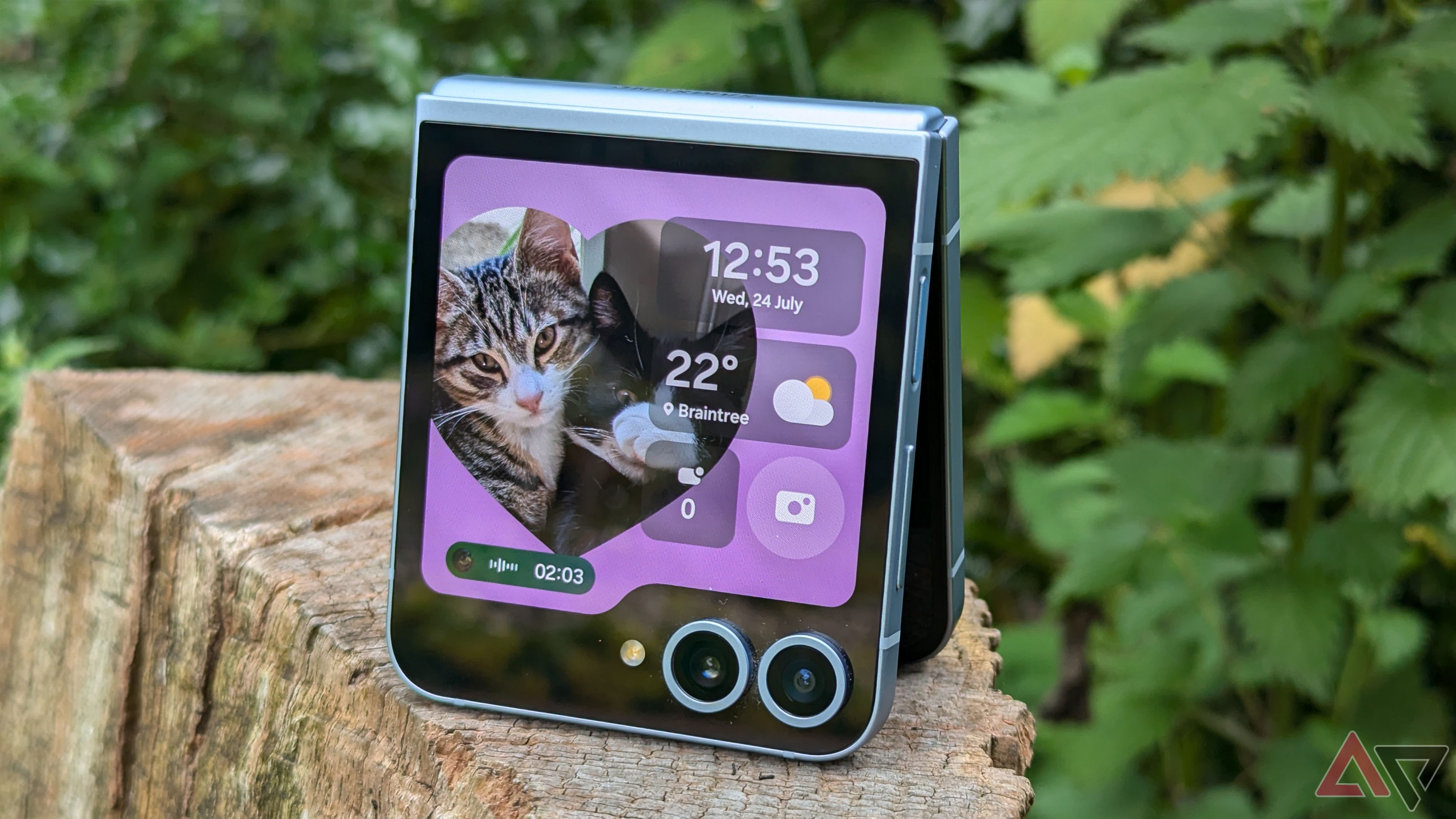Nearly five years after Samsung’s first foldable phone hit shop shelves, the company has arguably cornered the market regarding the flexible phones you see out and about on the streets. The technology from its rivals, Motorola, Google, and Chinese manufacturers, such as Oppo, Huawei, and Xiaomi, has proven interesting. Still, you rarely see any normal person using one of these phones. You rarely even see one of the company’s Fold handsets in a normal person’s hands.
If I spot a foldable phone in the street, it’s almost certainly a Galaxy Z Flip model of the five the company has released so far (Samsung skipped over the Galaxy Z Flip 2 name in 2021). That’ll continue to be the case for this year, but is the Galaxy Z Flip 6 worthy of the title of the most prolific foldable phone? It’s the default option for those who want a clamshell foldable phone in 2024, but competition from rivals is hotting up, and it may be time to look elsewhere for alternatives away from Samsung.
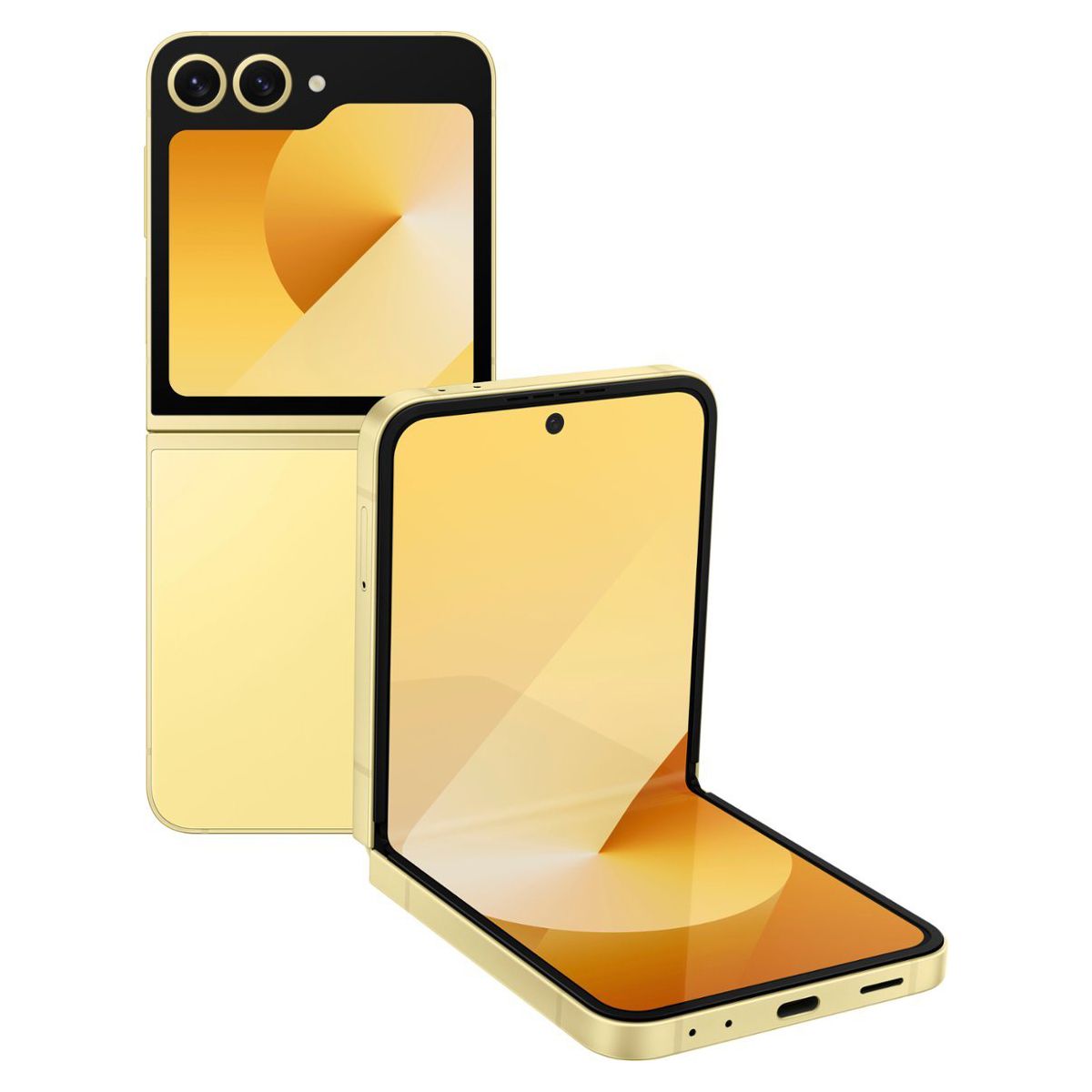
Samsung Galaxy Z Flip 6
The Galaxy Z Flip 6 is Samsung’s most evolved take yet on the flip-style foldable form factor. Its 3.4-inch AMOLED cover screen supports Galaxy AI features without opening the device, along with upgraded widgets and suggested replies. However, its gorgeous 6.7-inch FHD+ AMOLED folding display will still have you flipping the phone open quite a bit.
- Better battery life than ever
- Fantastic inner screen
- The best design yet
- Limited outer screen
- Still only 25W charging
- Why is it $100 more?
Availability and network
Samsung’s Galaxy Z Flip 6 is available in all the usual places, so you can buy it from Amazon, Best Buy, and most electronics retailers. You can also get it on practically all US carriers, and if you buy the unlocked version, you’ll be able to use it on an MVNO of your choice. The phone was revealed in mid-July alongside the Galaxy Z Fold 6, Galaxy Ring, and Galaxy Watch 7. The Z Flip 6’s release date was July 24, but some people received the phone earlier if they preordered the handset.
The biggest change this year is that it’s $100 more than the Galaxy Z Flip 5. 2023’s phone had a satisfyingly round price of $1,000 for the 256GB version, but that has jumped up to $1,100 for the basic version this year. The 512GB variant of the phone is $1,219. Expect to see those prices drop slightly throughout the year. Colors available include Yellow, Mint, Silver Shadow, and Blue from most retailers, with the Online Exclusive colors consisting of White, Peach, and Crafted Black.
Design and display
Minor changes this generation
If you’ve used a Galaxy Z Flip phone in the past, you’ll know most of the design language of Samsung’s latest clamshell. There are tweaks to make it the most easy-to-use foldable yet from the company, but there aren’t many huge design differences, especially compared to the Galaxy Z Flip 5. Most of the changes are difficult to spot with the naked eye.
This is the best feeling and looking clamshell phone from the company so far. I’ve been using the Blue version of the handset, which feels premium while also eye-catching. I’ve had multiple compliments on the look of the phone over my testing period, but I’d argue most people wouldn’t have noticed this is the new generation phone over the last couple of years of handsets.
This is the first Flip phone to feature an IP48 rating, which means it’s more dust-resistant than previous iterations. Note that the dust resistance is still limited here, so you will want to avoid elements like sand getting to interact with the Z Flip 6. The hinge technology makes the screen more durable than ever, and JerryRigEverything’s durability test proves it’s doing well from that point of view. You’ll still want to be careful, and I’d recommend getting one of the best Z Flip 6 cases to protect it from drops, but any improvements Samsung makes in this area are essential.
The brushed metal effect around the handset feels good, but it won’t be to everyone’s taste. One small but notable design choice is how the cameras now have an outline of the color of the rest of the phone to help them stand out.
The phone’s dimensions are almost identical to those of the Galaxy Z Flip 5, at 165.2 x 71.9 x 6.9mm, unfolded weighing 187 grams. That weight feels good in the hand without proving too heavy. The only minor difference in dimensions is that the phone is slightly thinner when folded at 14.9mm, which is likely because the screen now fits tighter together and tweaks the company has made to the hinge tech. The way the phone folds together feels tighter than previous generations, making it feel more secure.
The outer screen on the Z Flip 6 remains the 3.4-inch Super AMOLED with a resolution of 720 x 748. It’s fine, but it’s far from great. We’ve seen the new Motorola Razr+ feature, which is a better outer screen tech than Samsung’s offering here. It makes you less likely to use this outer display, which is meant to be one of the big benefits of using a foldable phone. This screen remains basic compared to alternatives like Motorola, and it’s one way that Samsung feels like it’s being left behind in this race.
Inside is the 6.7-inch AMOLED with a resolution of 1080 x 2640. The big upgrade this year is improved brightness, which is noticeable at 2600 nits compared to the 1750 nits on the Z Flip 5. The inner display is best for most daily tasks, but it did mean I was often opening the phone for tasks I wanted to be able to do from the front display. The more you open the phone, the more battery you’re using.
The company’s Adaptive screen refresh rate looked good while scrolling through apps. It smartly switched between 120hz for available services and reduced it to save battery life when it wasn’t necessary.
If you’ve never used a clamshell foldable before, just know you’ll need to use two hands with this product regularly. The long screen means you often can’t reach the top of the screen with the hand you’re holding it with. It’s just something worth noting if this is your time making the switch from Candybar to Foldy.
Other hardware and what’s in the box
The speakers on the Z Flip 6 are good enough for watching the odd YouTube video or listening to a podcast, but I wouldn’t recommend them to someone looking for a rich audio experience. If you’re looking for better speakers, you likely want to opt for Samsung’s bigger foldable choice.
As with most recent Samsung products, don’t expect much in the box. There’s no charger, no case, not much at all. There is a USB-C charging cable and a SIM tool, but that’s all you’ll get. It feels frustrating that Samsung doesn’t include its 25W charger by default here with the Galaxy Z Flip 6, considering what it costs, but this is the case with most major manufacturers in 2024.
Software and performance
It’s all about AI
The Z Flip 6 comes with Android 14 software with the company’s latest One UI 6.1.1 skin on top. One of the big highlights is that you’ll get seven years of software updates from Samsung if you buy this phone, taking you through to Android 21 (or whatever Google decides to call it). That’s far better software support than the four years you used to get on Samsung products, and it makes investing this amount of money in a phone a touch more palatable, knowing that you’ll be able to remain using it safely until 2031 or even later.
Samsung’s software is beginning to feel purpose-built for foldable phones, and it’s one of the key highlights on the phone’s main screen. The company has worked out many of the teething problems it had in its early iterations, aside from one big one.
My biggest gripe with the Z Flip 6 is its limited cover display. As a default, you’re still using widgets on this smaller screen, and Samsung is restricting it to the apps it wants you to be able to use. At launch, those are limited to Calculator, Calendar, Clock, Contacts, Gallery, Global Goals, Google, Health, Phone, Reminder, SmartThings, Spotify, Voice Recorder, and Weather. Only two of those are third-party services, and while Samsung assures us more support is incoming, it feels like this company should have had this all prepped and ready to go.
These available widgets largely work well, and the way Samsung has introduced them is strong. Most functionality is possible through the outer screen, which wasn’t the case in early iterations of this phone. The main third-party option right now is Spotify, which is okay, but it only allows you to choose from eight of your most recently played artists rather than allowing you to search for what to play. You can pause and skip tracks, but you need to open up the phone to do anything more useful.
If you want to use more apps on your cover screen, you can do so through a Good Lock feature called Multistar. The app needs to be downloaded from Samsung’s service, allowing you to select the apps you want to load on your cover screen. You can then boot them up from a dedicated Multistar widget. This means the apps won’t allow for specific widgets, and the small screen isn’t always suitable for every service. Don’t expect an experience optimized for an odd aspect ratio 3.6-inch screen.
Samsung’s software is beginning to feel purpose-built for foldable phones, and it’s one of the key highlights on the phone’s main screen.
It’s a workable alternative, but I don’t understand why Samsung continues to bury this important functionality within a service most people won’t know where to find. Do turn this on if you buy the Galaxy Z Flip 6, but just know you’re likely to come across some frustrations that will likely mean you’re opening up the main display to access full functionality across your apps.
Taking Spotify as an example again, using it through Multistar offers near-perfect functionality. You can search for artists, scrub through tracks, access playlists, and do everything else you can do on the main app. I’d argue this is more helpful than the widget, and I found myself often returning to use it rather than Spotify’s own purpose-built application.
The first two photos show Spotify’s widget, the second two photos show the app used through Multistar
Elsewhere, Samsung’s big focus for this year is Galaxy AI technology. It’s building its Galaxy AI services into all of its apps at the moment, which means the phone is inundated with areas where you can use the service to help supercharge your life. For example, you can now use it to summarize voice recordings, so you can record a work meeting and then have a shorter version to refer back to alongside the transcription.
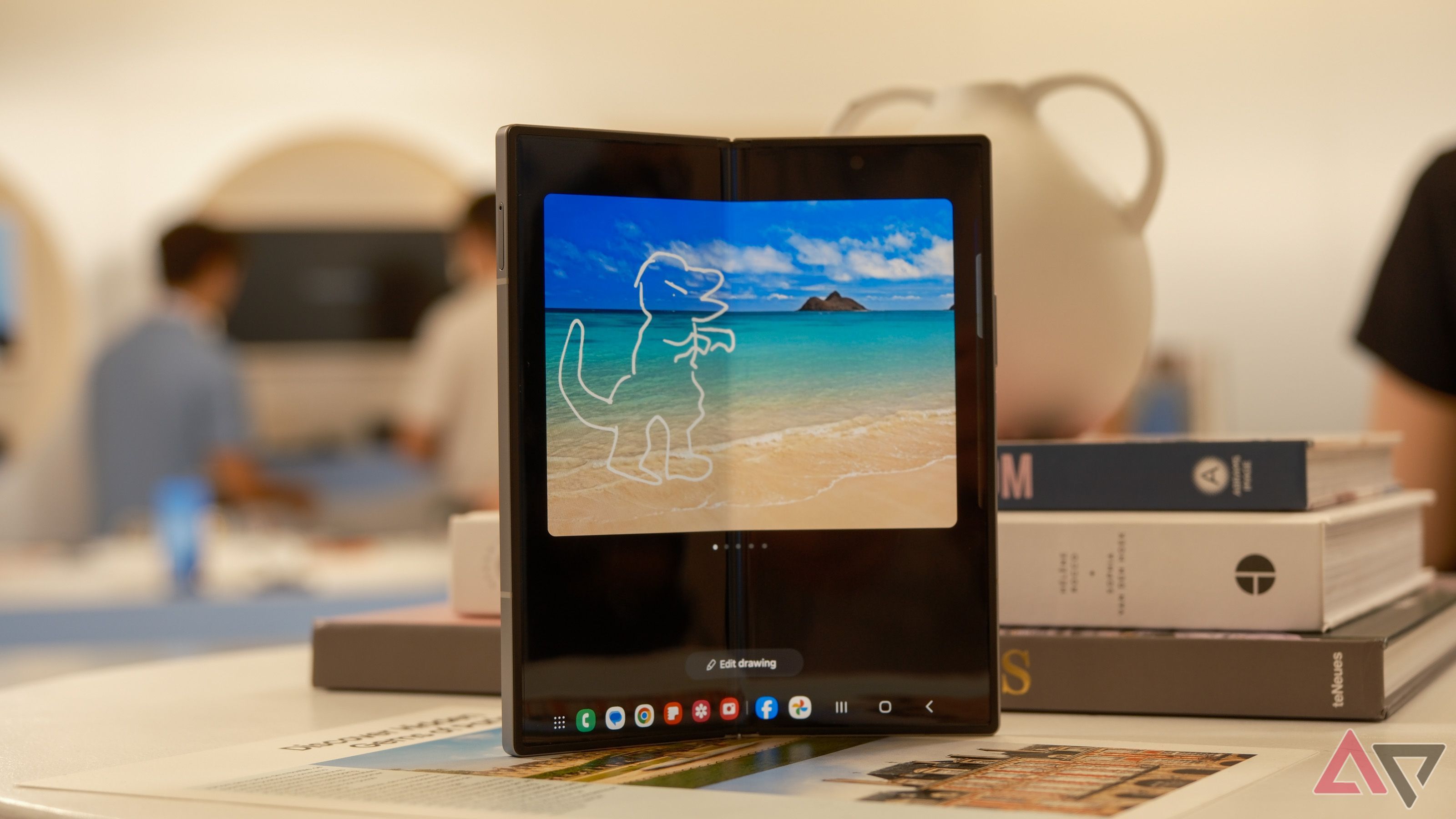
Related
10 best Galaxy AI features every Samsung owner should try
From writing assist to live call translate
Many of these features debuted on the Galaxy S24 series earlier this year, and they’ve now made their way to these foldable phones. The exclusive features are small, but there are a few notable highlights.
One feature I haven’t had the opportunity to test in full yet is called Samsung’s Interpreter Mode. You may have seen this in the company’s ads, where it allows you to talk into the phone’s translation app, and it’ll then display the translated text on the phone’s outer display while you use the inner display to see the incoming messages in your native tongue.
There are many other Galaxy AI features in the camera app. Most of these are fun things I’ve played with for a couple of hours, but I don’t expect them to change how I take photographs. These include AI-generated portraits that make you look like an anime character or sketch out your face.
The original photo, then in Comic, 3D Cartoon, Watercolor, and Sketch
The most fun is Sketch to image; this feature allows you to draw on top of any photograph you have, and Galaxy AI will then introduce AI elements to the photo. The example used in Samsung’s marketing is you can put sunglasses on pets, so I tried to do that and got the following result:


Some of the results are strange, as we’re consistently finding with most AI services. My colleague Taylor Kerns managed to accidentally give his dog a Pokemon-themed bong in one example, and one hat I tried to draw on my cat turned into a tombstone. It comes down to how good your drawing is and whether the AI can realize what you want, but it’s a fun tool to play around with. I wouldn’t say it’s a reason to buy this phone.
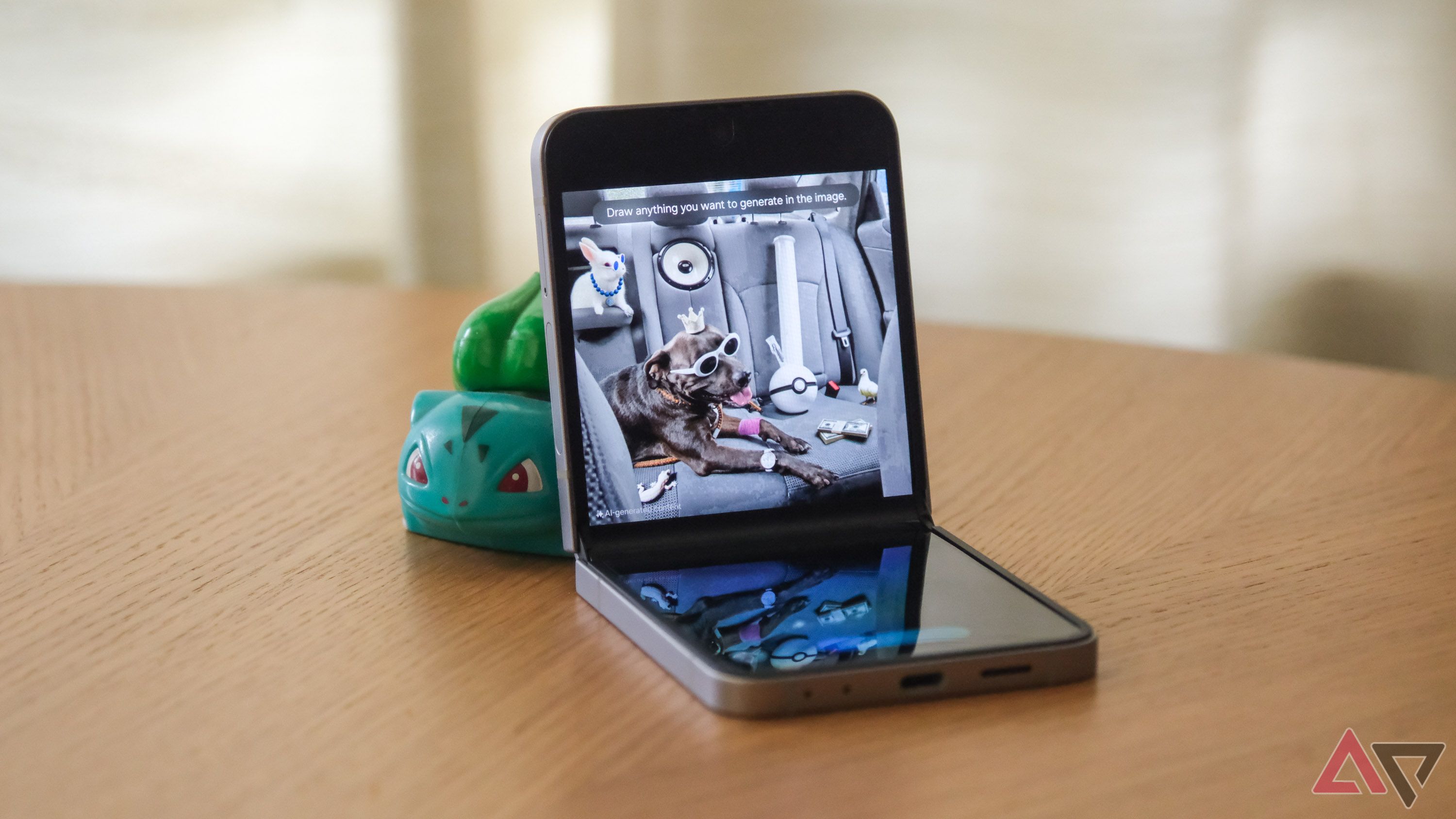
Related
I didn’t care about Galaxy AI until it gave my dog a Pokémon bong
Sketch to image can do some very silly things
Throughout my week with the Galaxy Z Flip 6, I’ve found the phone to have top-tier performance and can handle any activity I want to throw at it. The Qualcomm Snapdragon 8 Gen 3 chipset inside is working well, and the company’s move to upgrade the base model to 12GB of RAM has given the phone more grunt than previous versions.
The phone never felt hot, even during more intensive sessions such as mobile gaming, and I’ve found it able to cope with multitasking elements. There were rumors of Samsung switching away from Qualcomm for this generation, but it made the right decision and kept the more powerful alternative on its foldable for 2024.
Camera
A notable step up
Samsung has heard our criticism of its foldable cameras, and it’s moving in the right direction on the Galaxy Z Flip 6. This is a remarkably similar camera to the standard Galaxy S24, with a 50MP f/1.8 main sensor taking on the brunt of the hard work. There’s then a 12MP f/2.2 ultrawide camera with a 123-degree field of view. The big difference from the Galaxy S24 is there isn’t a telephoto camera here, which some users may miss.
Focusing on the main camera, I found the images detailed in a way I haven’t done on previous Samsung flip foldable phones. Everything was clear throughout all of my camera samples. The camera defaults to 12MP pixel-binned photos, but you can also change it to 50MP within the settings. I found both produced good results that were far better than previous foldable phones from the company.
I believe the colors were oversaturated a little, but that’s a matter of personal preference. Depending on which side of the fence you sit on, Samsung is often criticized or praised for this.
The ultra-wide camera proved good, but it’s noticeably weaker than the main camera, with some shots losing some of the detail you may expect from this sort of camera. I also missed the telephoto element on this phone. I kept jumping into the zoom on the phone, surprised to see it would only go up to 10x compared to Samsung’s other phones. This probably isn’t a problem for everyone, but if you’re moving from a phone with a strong telephoto camera, know that you’ll lose this here.
The ultra wide camera, standard, 2x zoom, 5x zoom, 10x zoom, and selfie
The internal selfie camera on the Z Flip 6 is fine, but it won’t be your go-to choice. It’s designed for video calls when you’ve got the phone unfurled, but I always found myself using the main camera with the cover display whenever I wanted to take a selfie. The fact you’ve got the option to switch between the two is helpful, and it instead means you’re just using the standard 10MP selfie camera on the odd occasion when you need to.
It has never made sense to me that Samsung’s foldables had to include worse cameras than its flagship line. When spending this much on a smartphone, you want the full package. Samsung isn’t quite there yet with the Galaxy Z Flip 6, but it’s closer than ever, and I think there are only a few scenarios where you’d struggle to
Battery life and charging
The good news is that battery life here is better than previous iterations. The cell is 300mAh bigger than last year at 4,000mAh, and it’s clear that Samsung has made some refinements here to improve the battery life. It’s still not fantastic, but the Galaxy Z Flip 6 would get me through daily without recharging. Even on my busiest day of using the phone in the city center, I found the battery remained with 5% left at the end of the day, ensuring I made it back home without any issues.
I can’t help but think about how, if the outer display was better used on this phone, I would end up experiencing far better battery life.
Little else has changed on the Z Flip 6 regarding battery. There’s 25W wired charging, which is fast falling behind the competition. This is an area I’d have loved to have seen Samsung improve on this year. Wireless charging is at 15W, which is to be expected, and there’s 4.5W reverse wireless charging for your accessories. Without a charger included in the box, you’ll likely want to buy your own 25W wired charger to ensure you can get the best results.
Competition
Samsung has some serious competition now
In the US, Samsung hasn’t had much competition in the flip-foldable space. Motorola is the main competitor, and most of the exciting other handsets on the market have been from Chinese manufacturers that don’t sell in the country. This year is a little different, with the Motorola Razr 2024 series picking up the gauntlet and making an exciting edition of its handset.
Motorola’s foldable phones have never been that exciting and often trail Samsung, but they’re a genuine contender in 2024, and they’re arguably better in a couple of key ways, with the outer display performing better than on the Samsung.
The other big competitor here is Samsung itself. The Galaxy Z Flip 5 is a remarkably similar phone, and it launched at a lower price. In the last 12 months, that price has fallen even further. The big thing to note here is that you’ll only get a guaranteed three years of software updates from the older generation. Samsung offered four years, and we’re already one year through that.
The other options you have are book-like foldables, such as the Galaxy Z Fold 6 or OnePlus Open. These are ultimately a different proposition, and they’re unlikely to be what you’re looking for if you’re after a clamshell foldable. However, bear these in mind as an option for your foldable phone if you’re looking for something different.
Should you buy it?
If you like the polish of Samsung, it may be ideal
The Galaxy Z Flip 6 is a largely boring iteration of Samsung’s design for the last five years. As I noted at the start of this review, if you see a foldable phone on the street, it’s likely a Galaxy Z Flip. I do find it difficult to tell the difference between each model, though, as Samsung’s iteration has been slow on this series.
I’m also not sure that it will continue to be the default foldable option in the years to come if Samsung refuses to make any big changes to its design in the next few years. This is by far the best Galaxy Z Flip phone the company has released with this year’s tweaks failing to set headlines alight, but the changes are helpful in your everyday phone. That said, if you own a Galaxy Z Flip 4 or 5, you’re going to feel disappointed by these changes, and you may look toward the Motorola Razr+ (2024) with some jealousy.
If this is your first time opting for a foldable handset, the Galaxy Z Flip 6 is a great option. It’s likely to be one of the best ways the company holds this design, and at least for the next few years, it’s going to give you a great experience. Samsung’s move of seven years of software updates over the Z Flip 6 series is also a huge boon for everyone who wants to buy a phone and keep it for the better part of a decade.
That said, I’m not sure what that extra $100 over last year’s 9 out to 10 phone gets you. Everything is slightly better, but there aren’t any game-changing updates I can point to that I would recommend a Galaxy Z Flip 4 or 5 owner should opt to upgrade right now. If that’s you, I’d likely hold off until 2025 to see what Samsung does next. If you’re keen to jump into the world of foldable phones and that extra price doesn’t put you off, you may want to upgrade right now.

Samsung Galaxy Z Flip 6
The Galaxy Z Flip 6 is Samsung’s most evolved take yet on the flip-style foldable form factor. Its 3.4-inch AMOLED cover screen supports Galaxy AI features without opening the device, along with upgraded widgets and suggested replies. However, its gorgeous 6.7-inch FHD+ AMOLED folding display will still have you flipping the phone open quite a bit.
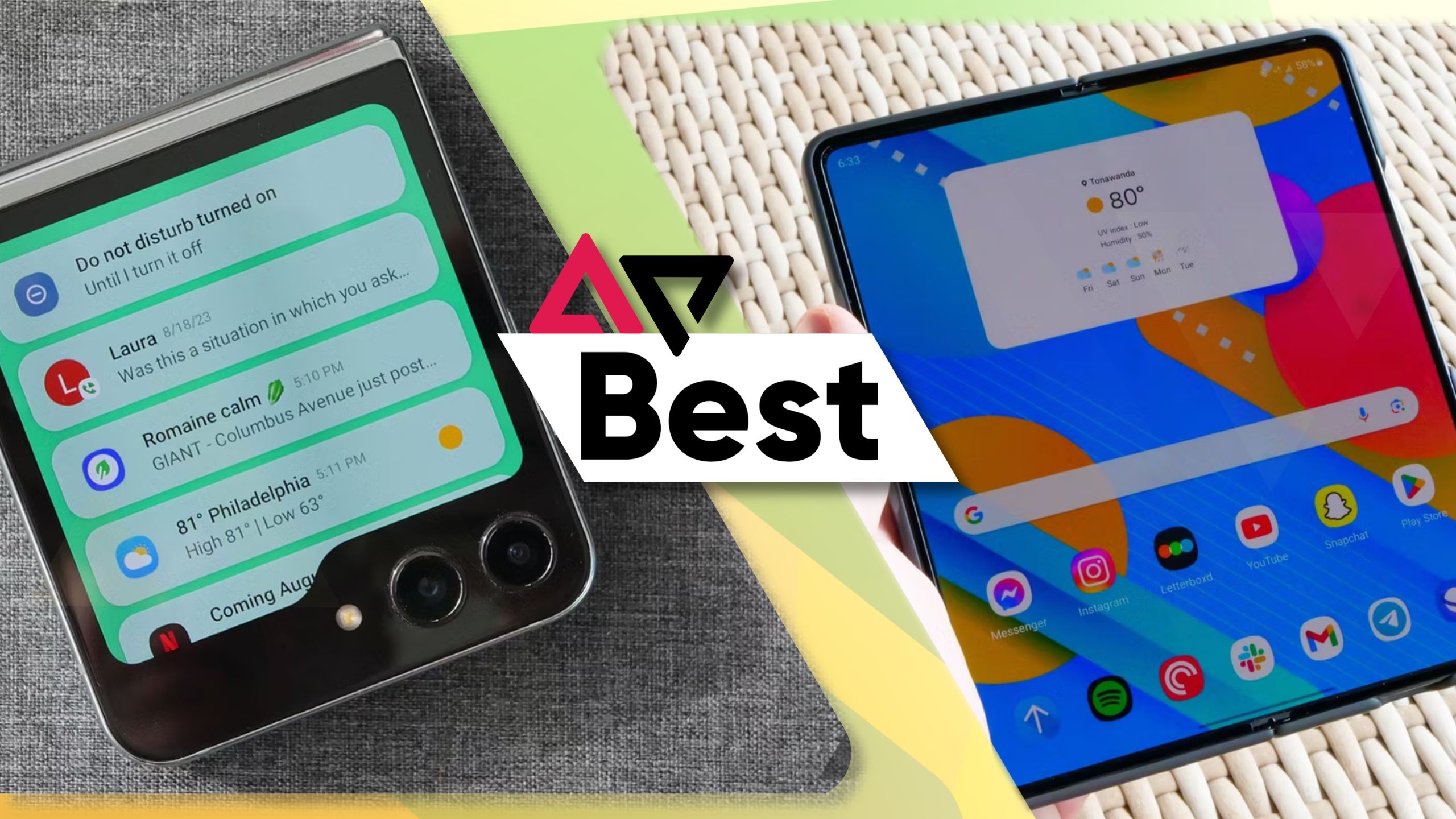
Related
Best foldable phones in 2024
Flip phone or folding tablet, there’s something for you
Source link

